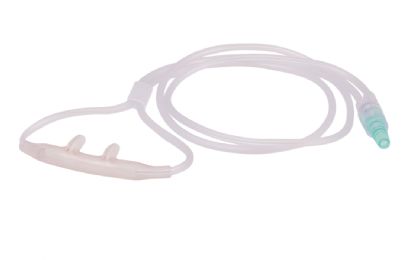
-2.jpg&newheight=260&quality=80)













What is a Nasal Cannula?
Used in conjunction with oxygen tanks and other oxygen delivery systems, a nasal cannula is the long tubing that connects one end to the tank, and the other end to the user’s nose. This lightweight tubing splits at the nasal end, with two prongs that fit comfortably into each nostril. Oxygen flows through the cannula from the tank or delivery system into the user’s nostrils for supplemental oxygen therapy. At the nasal end, the cannula also makes a loop around the patient’s head, usually hooking around each ear to better hold the nasal cannula in place.
Who uses a Nasal Cannula?
Utilized by individuals with COPD, pulmonary hypertension, cystic fibrosis, sleep apnea, chronic asthma and other respiratory disorders, supplemental oxygen therapy is also often indicated for bariatric patients, those with heart failure and anyone who gets tired or out of breath with walking or movement.
Nasal cannulae are attached to various forms of oxygen delivery systems, from portable oxygen generators to large stationary tanks. Most cannulae can flow anywhere from 1 to 5 liters of oxygen per minute, dependent upon the system and the individual patient’s needs. Smaller pronged nasal cannulae are especially designed for more efficient usage by infants and children.
More comfortable and much less intrusive than a non-rebreather oxygen mask, a nasal cannula is often used by patients who can greatly benefit from supplemental oxygen therapy but who don’t require this therapy to self-respirate. Users can continue to communicate, eat and drink while receiving oxygen therapy through a nasal cannula. This oxygen delivery device also helps to reduce the risk of rebreathing carbon dioxide, a problem that sometimes occurs with oxygen masks.
Because the flow rate of oxygen therapy delivered via nasal cannulae is dependent upon each user’s breathing rate and pattern, oxygen transferred through this method is variable. Patients with more acute COPD or who require more controlled oxygen therapy should use masks rather than nasal cannulae.
Benefits and Tips for Using a Nasal Cannula
One of the greatest benefits for using supplemental oxygen therapy is that it may help extend the life of the user. Most patients receiving this therapy report increased energy levels, greater mental acuity, enhanced breathing, and longer, deeper sleeping patterns at night. Because a nasal cannula is not nearly as invasive as an oxygen mask, most oxygen recipients tend to have a better follow-through on compliance and use the treatment as they have been prescribed.
While one of the most common complaints with using nasal cannulae is dry nasal passages, this problem tends to correct itself relatively quickly after regular therapy has begun. If this does not resolve by itself, there are several efficacious ointments and sprays on the market to specifically treat this drying issue. The fit of the nasal cannula into the nostrils can also often be adjusted to relieve any irritation that may be occurring.
Oxygen therapy provides wonderful benefits for the user, but it does not come without certain risks. Some physical complications may arise with prolonged treatment, such as losing the ability to expel mucus from the lungs. Be sure to contact your physician or get medical help immediately if you start to have trouble breathing, or if you notice a bluish tint to your fingernails or lips.
As with any oxygen use, it is important to post “No Smoking” signs and to keep all flammable items removed from the vicinity where it is being utilized. Oxygen is extremely flammable and should always be kept away from stoves, candles, petroleum products, aerosols and anything that can give off a spark.
Rehabmart is pleased to offer superior quality nasal cannulae and related oxygen therapy supplies from renowned medical vendors that include Drive Medical, Independence Medical, McKesson Medical-Surgical, Invacare, Responsive Respiratory Inc., Contour, Mada Medical and Roscoe Medical.
Hulet Smith, OT
Rehabmart Co-Founder & CEO
ck